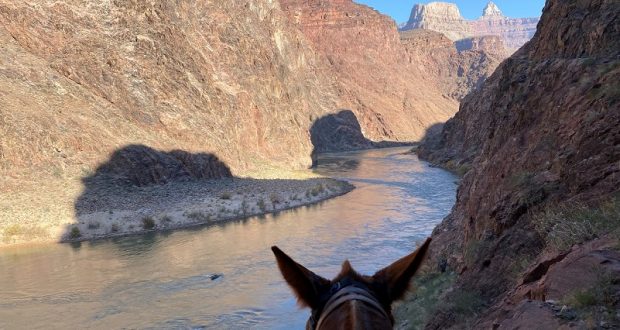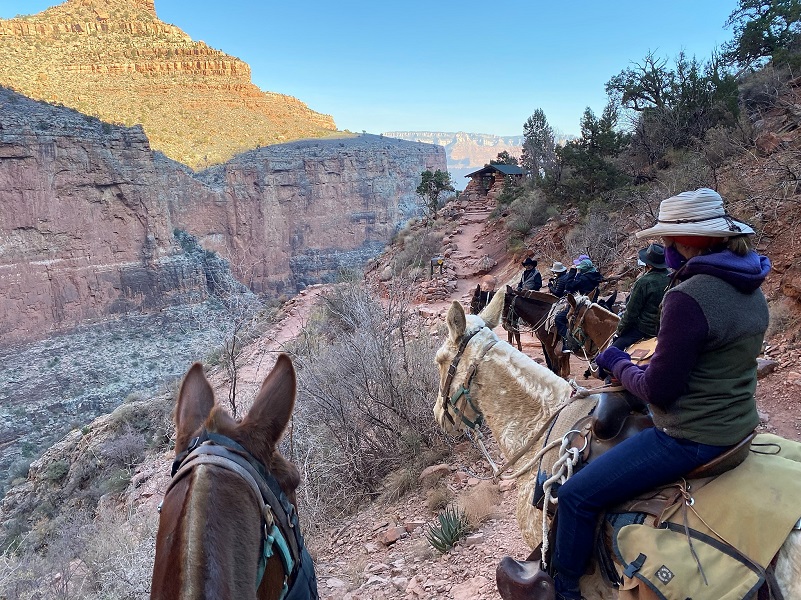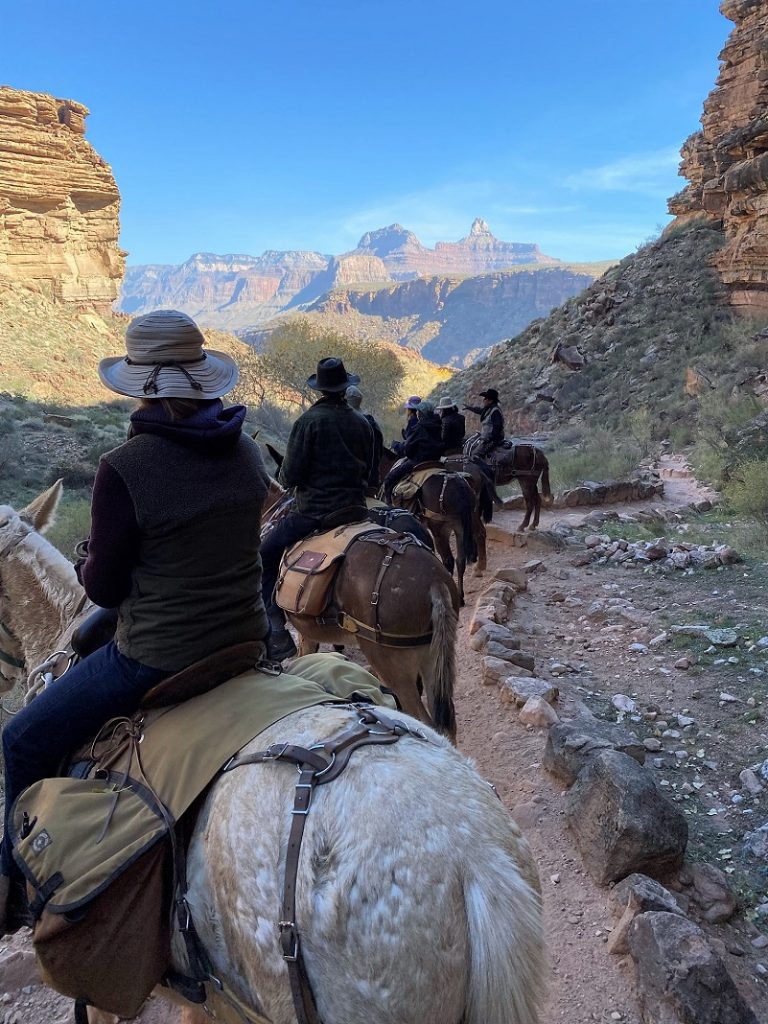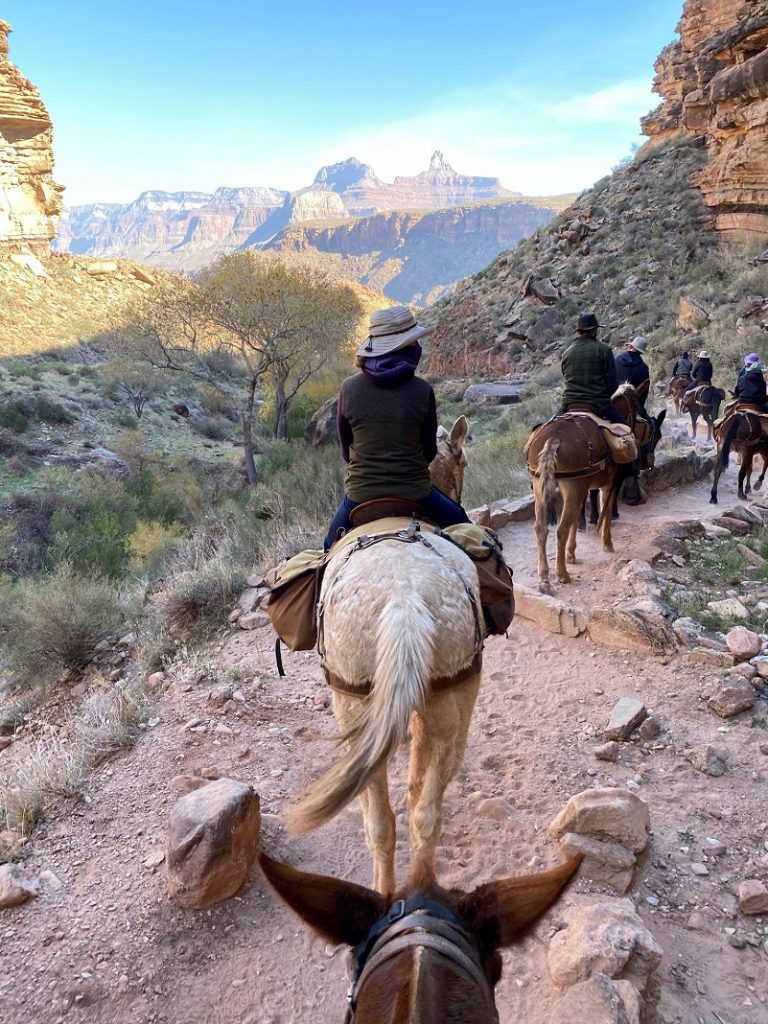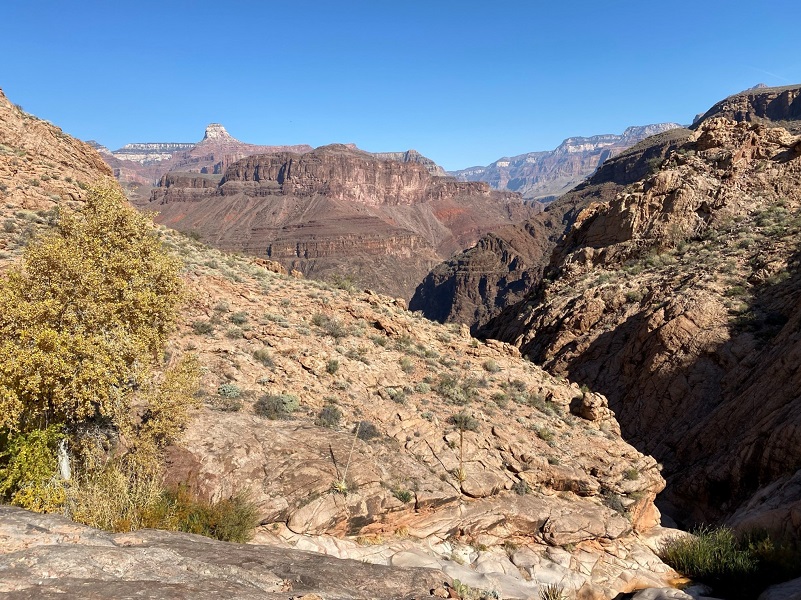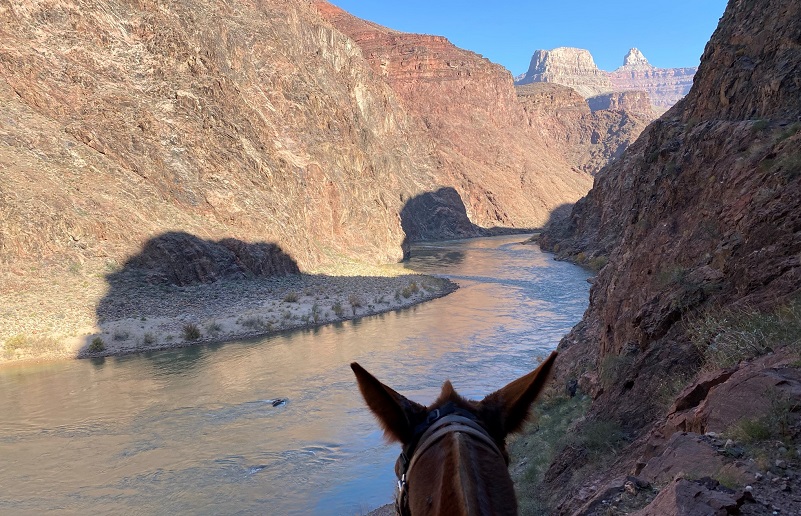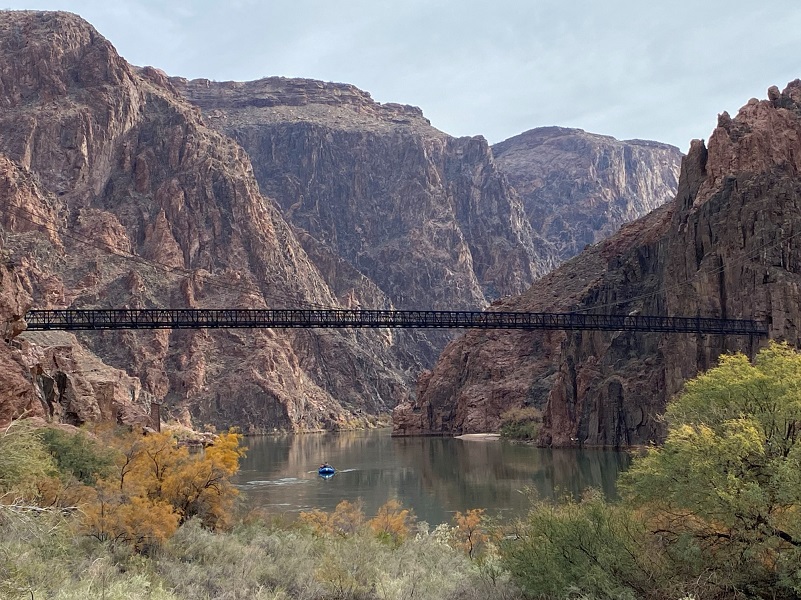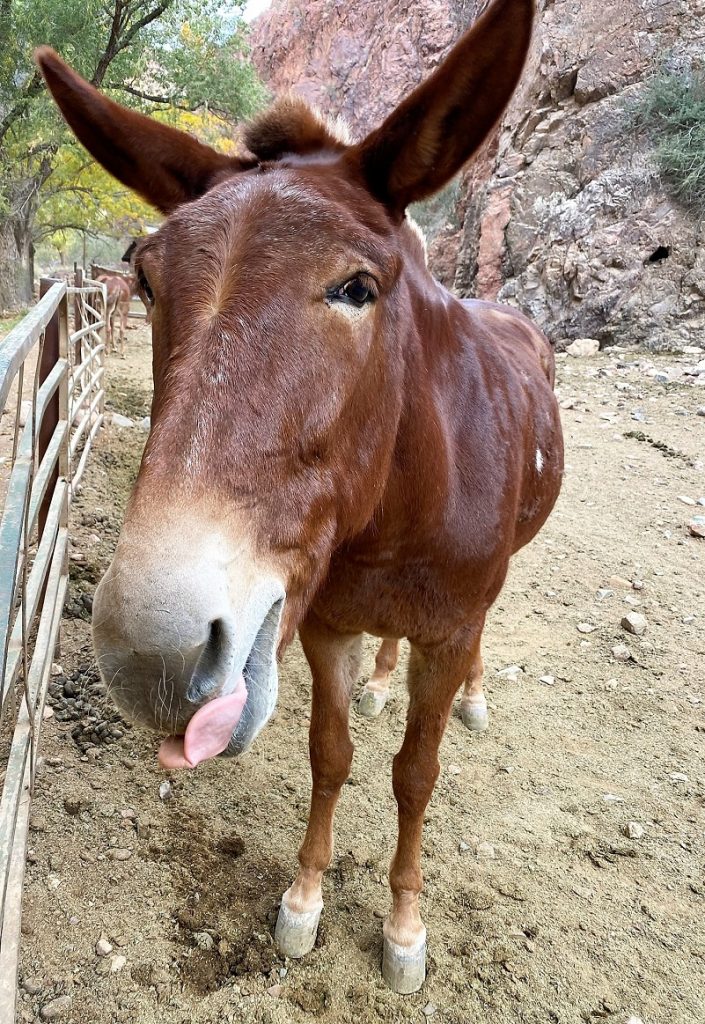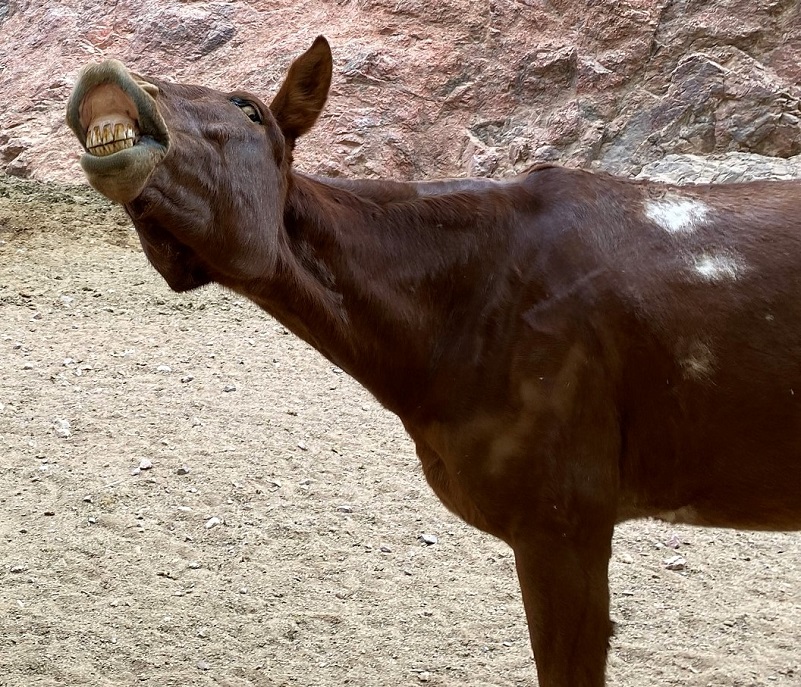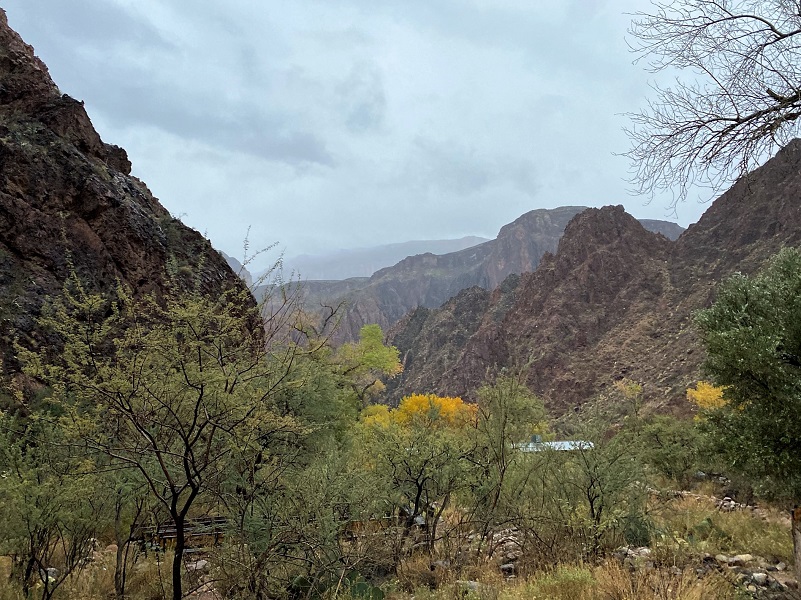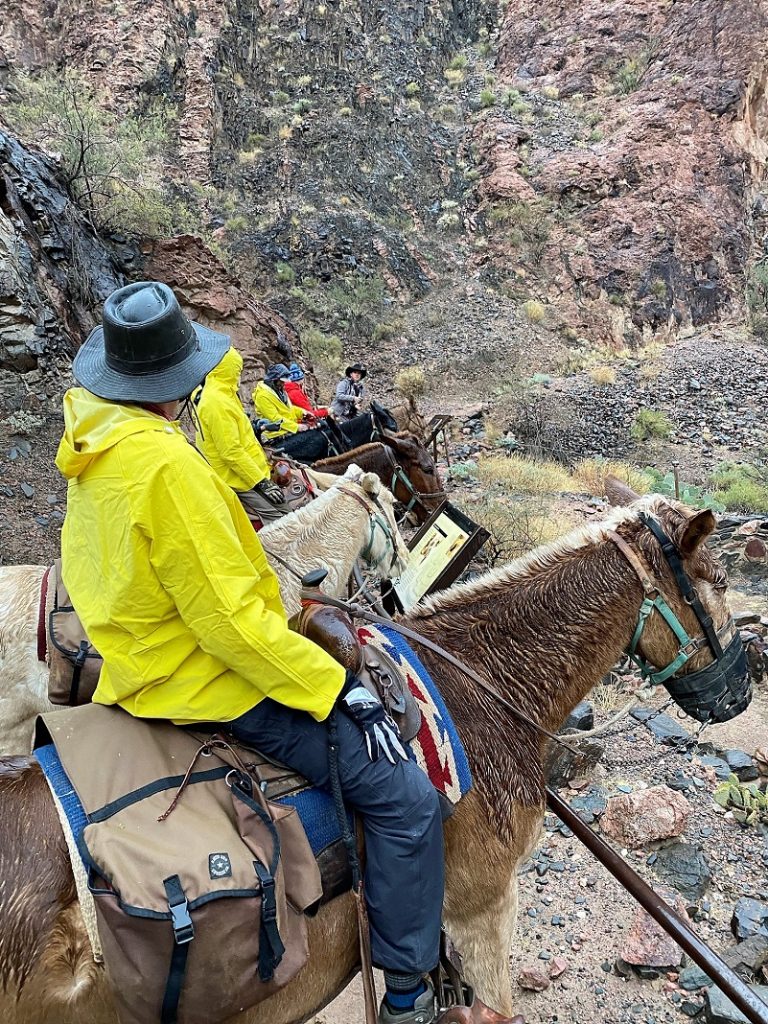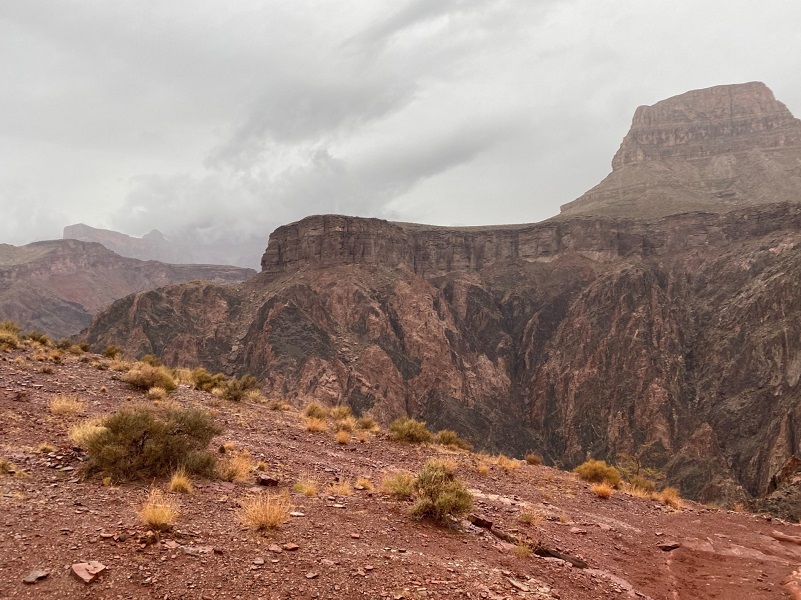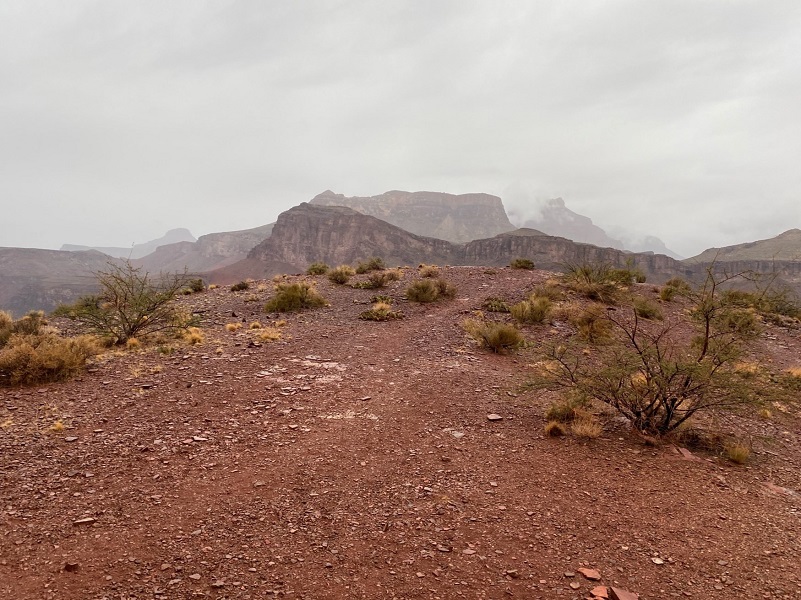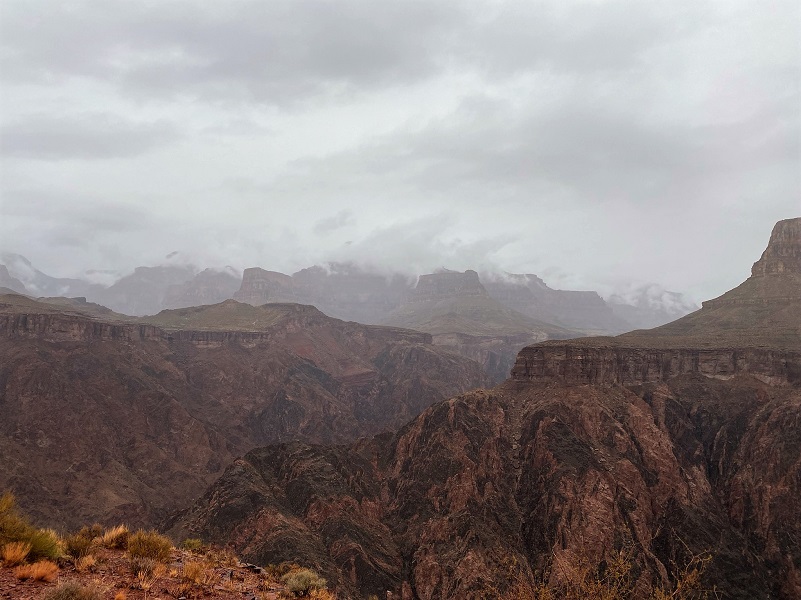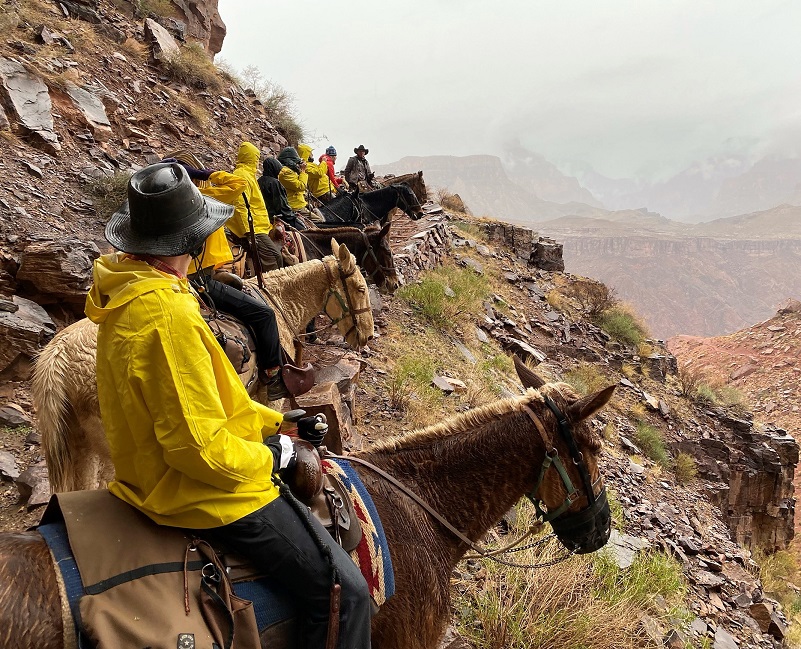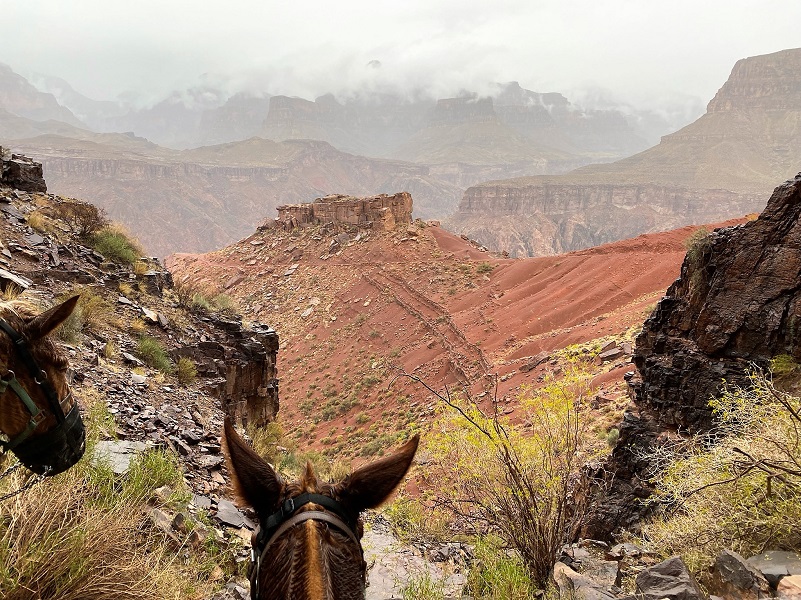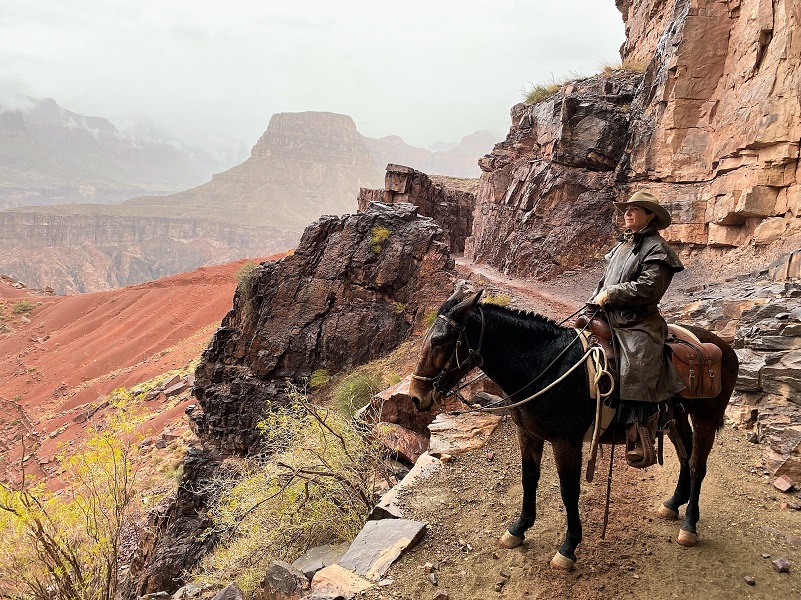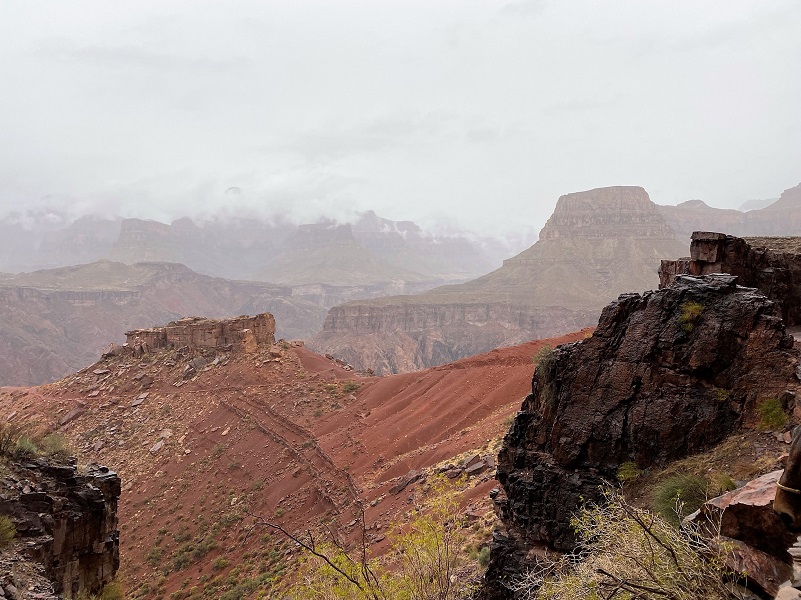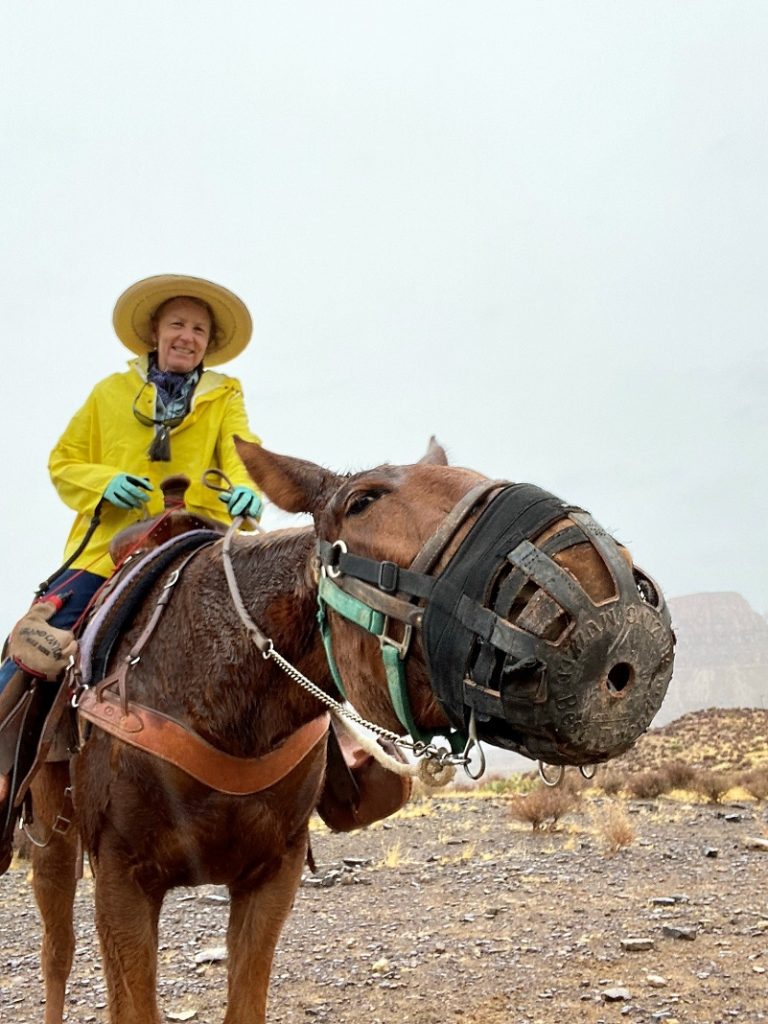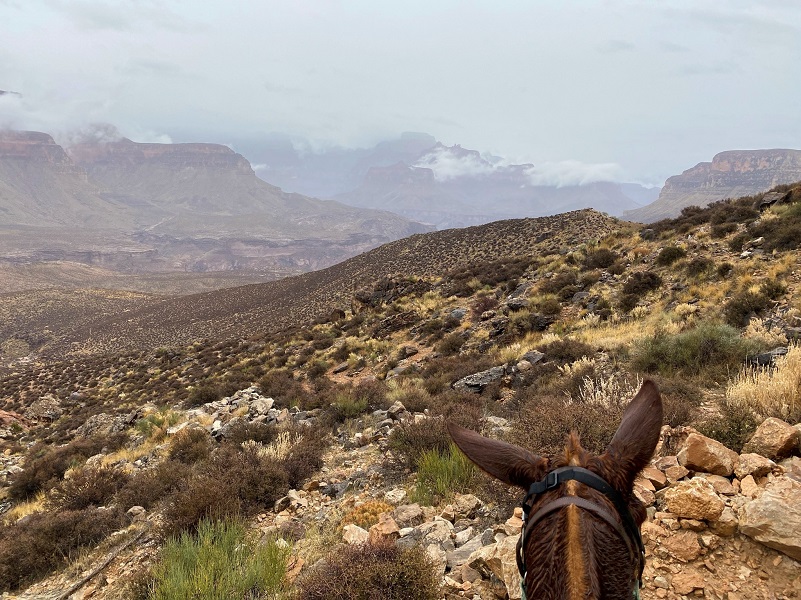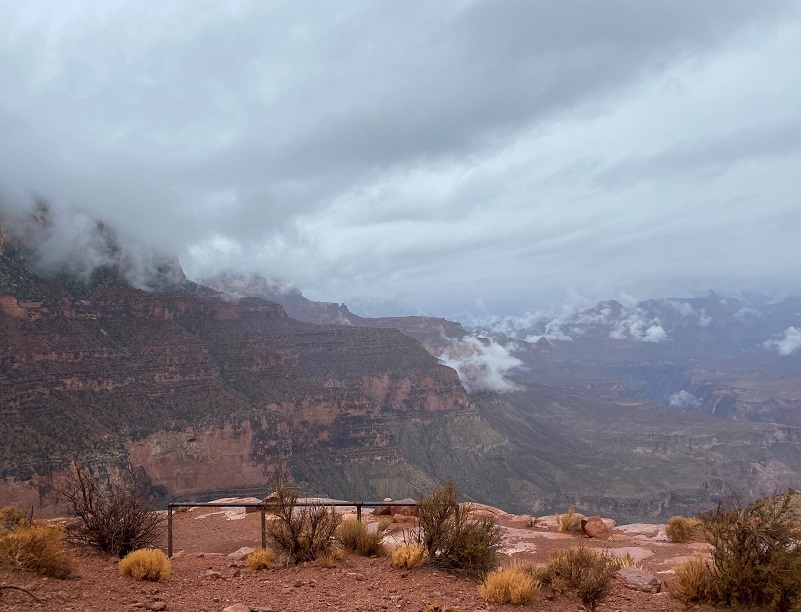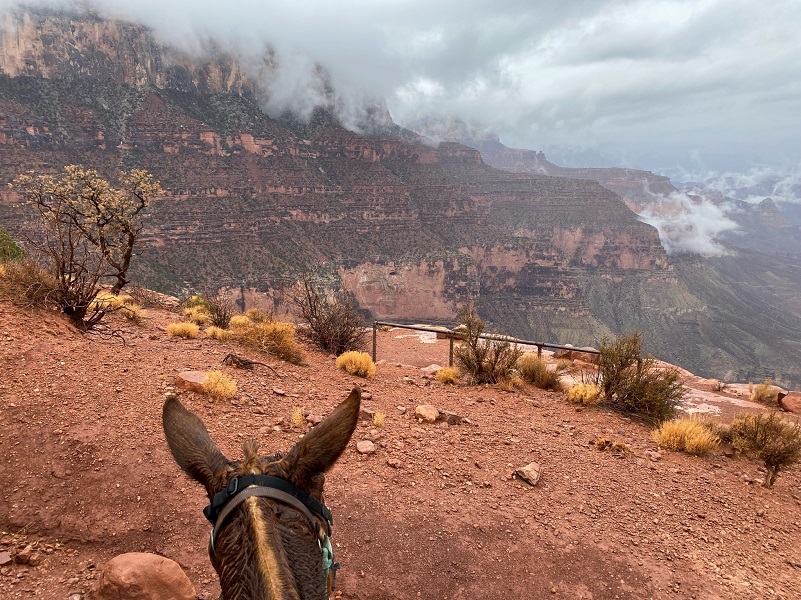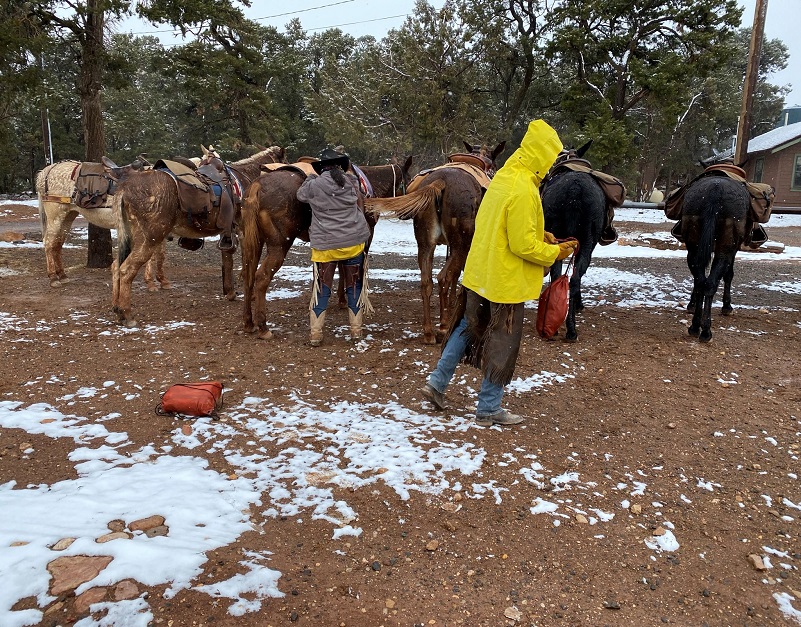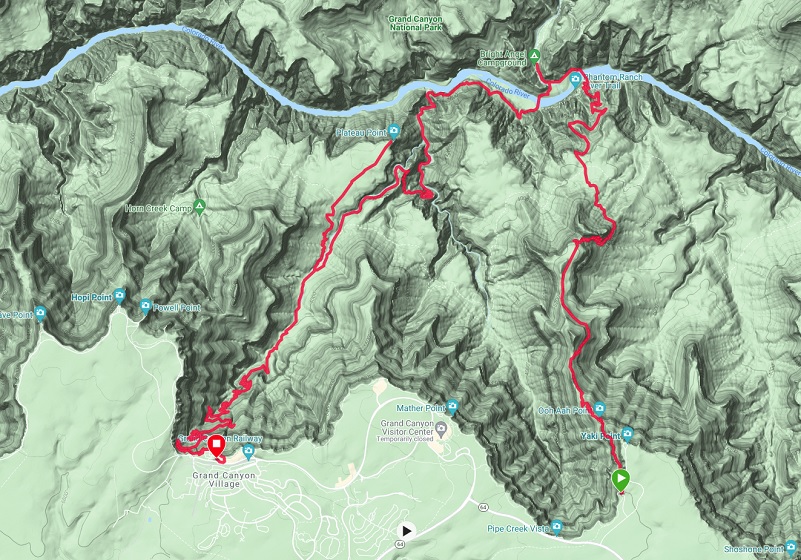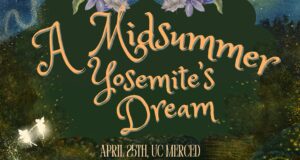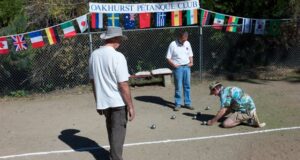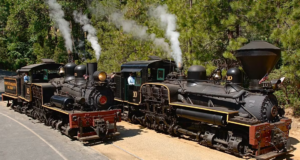The mule ride down to the bottom of the Grand Canyon with a stay at the historic Phantom Ranch had been on my To Do List for a while and I got her done! Unbelievably beautiful, colorful and ever changing light on the canyon walls was around every switchback on the trail. It was absolutely incredible to learn that we were riding through so many old layers of time, the oldest rock being 1.8 billion years old.
Where: Grand Canyon National Park, Arizona
Distance: About 15 Miles
Difficulty: Easy to moderate
Elevation Range: 2,408 – 7,196
Elevation Gain: 9,643′
Date: December 5-7, 2021
Dog Hike? No
I have been waiting a few years to do this trip, putting in for it back in 2019. It is a popular trip that you have to put in for at least 1 year ahead of time. So, I planned on going in December 2020 but COVID started happening around January 2020 and I delayed the trip to 2021 so this was the year. There were modification made for this mule trip due to COVID such as limiting the size of the riders to 10, not sharing cabins at Phantom Ranch and requiring masks while in all buildings in the national park, regardless of vaccination status.
The overnight rides start at the South Rim and go down to the bottom of the Grand Canyon, staying overnight at Phantom Ranch. I had wanted to maximize my time down there so I opted to stay 2 nights there. I wrote 2 blogs about this adventure, the first on the mule ride and the second on my stay at Phantom Ranch.
 We were sent information ahead of time on what to wear and what to pack. The directions said that they would provide a small plastic bag, about the size of a 10 pound bag of ice and we had to pack everything we carried in this. It would be put in a saddlebag for the mules to carry down. You could add additional duffels if arranged ahead of time for a price and one of our party brought down their CPAP machine. I really had to fine-tune what I was bringing because I planned on spending a day hiking at Phantom Ranch. But, imagine my surprise when I checked in and they gave me TWO bags to pack my things into because I was spending 2 nights. Wowie! I had brought tons of things in my car with me because I wasn’t absolutely positive about the weather so was able to cram those bags with all kinds of things to make my stay more comfortable. I could fit my light hiking shoes and extra layers in!
We were sent information ahead of time on what to wear and what to pack. The directions said that they would provide a small plastic bag, about the size of a 10 pound bag of ice and we had to pack everything we carried in this. It would be put in a saddlebag for the mules to carry down. You could add additional duffels if arranged ahead of time for a price and one of our party brought down their CPAP machine. I really had to fine-tune what I was bringing because I planned on spending a day hiking at Phantom Ranch. But, imagine my surprise when I checked in and they gave me TWO bags to pack my things into because I was spending 2 nights. Wowie! I had brought tons of things in my car with me because I wasn’t absolutely positive about the weather so was able to cram those bags with all kinds of things to make my stay more comfortable. I could fit my light hiking shoes and extra layers in!
 My adventure began at the stone corral adjacent to the historic Bright Angel Lodge. Our lead wrangler Simon led 5 of the mules in, followed by Reese with more mules. A total of 5 of us “dudes” plus the 2 wranglers were on the first day’s ride. 3 of us stayed for 2 nights and the other 2 rode back up the next day. A different pair of wranglers brought down 4 more riders on my second day and led us all out the third day.
My adventure began at the stone corral adjacent to the historic Bright Angel Lodge. Our lead wrangler Simon led 5 of the mules in, followed by Reese with more mules. A total of 5 of us “dudes” plus the 2 wranglers were on the first day’s ride. 3 of us stayed for 2 nights and the other 2 rode back up the next day. A different pair of wranglers brought down 4 more riders on my second day and led us all out the third day.
Safety requirements were reviewed with us, along with information about the trail and Grand Canyon. Then we saddled up, with stirrup adjustments made. I had my iPhone on a strap around my neck, tucked into my shirt so I could pull it out quickly and it wouldn’t bounce around, but we were discouraged to take pictures unless we were stopped.
We headed down the Bright Angel Trail, about 10.5 miles and taking about 5 ½ hours. We made several stops along the way, the wranglers sharing history and geology information along the way.
We stopped for a box lunch that they provided at Indian Garden. Both the mules and riders enjoyed the break.
We then headed along the rock face of the Inner Gorge
Then the trail led us along the Colorado River.
Then, believe it or not, through a tunnel, then over a suspension bridge.
This Black Suspension Bridge, along with the Silver Bridge located about 700 meters downstream, are the only spans in hundreds of river miles to cross the Colorado River. Mules travel across the Black Suspension Bridge, 700 feet long. We were told that the mules only cross on the Black Bridge and not the Silver Bridge because the it is wider, enough for 2 mules to pass by each other, although I don’t think I would want to be on one of those mules. Another reason given was that the Silver Bridge has a metal grid for the floor and mules don’t like that they can see down to the water. The Black Bridge’s floor is wooden planks. From Wikipedia:
Before 1907, the only way to cross the river was by boat, a dangerous method which cost many lives. Then, outdoorsman David Rust built a privately-operated cableway. The cableway was a six-foot by ten-foot steel cage large enough for one mule or several people would carry passengers across the river, but the passage was considered precarious. Theodore Roosevelt used the cableway in 1913. The second crossing was a suspension bridge that lacked stiffness. It was built in 1920 and proved to be too flexible to safely carry pedestrians across the river as the number of visitors to the park was increasing.
Black Bridge was designed by Ward Webber and constructed by John Lawrence. The Black Bridge was built in 1928. It would remain the only crossing of the river for hundreds of river miles until the Silver Bridge was built just downstream within the park during the 1960s. As motorized vehicles could not access the construction site, humans and mules transported the 122 tons in materials down the nine miles of trail. Walking single file, 42 Havasupai tribesmen carried the one-ton, 550-foot suspension cables.
The bridge was documented in the Historical American Engineering Record in 1984. On February 23, 2019, the bridge was recognized as a National Historic Civil Engineering Landmark by the American Society of Civil Engineers, saying, “The Kaibab Trail Suspension Bridge is a prime example of engineering innovation. Engineering this bridge at the base of one of the world’s greatest wonders – the Grand Canyon – illustrates the resourcefulness and innovative spirit of the civil engineers responsible for this project.” As of 2019, the bridge has remained unchanged since it was constructed 91 years ago.
I took some pictures of the Black Bridge the next day to help better show what it is like.
Once we crossed the Black Bridge, we headed up Bright Angel Canyon on the north side of the river to Phantom Ranch and I will share more about Phantom Ranch in the next blog. This is a good time to introduce you to my mule for this ride. His name is Sahara, born in Tennessee and about 10 years old. He was a wonderful mule for this ride, sure footed and I wouldn’t trade him for any other. And he had a little extra personality!
Some of you might be wondering how a mule is made? Mules are hybrid animals resulting from the crossbreeding of a horse mother and a donkey father. While it’s possible for horses and donkeys to breed in the wild, the vast majority of mules have been created by people through selective breeding.
Specific names are given to the offspring of a horse and a donkey depending on the gender of each parent. Mules result from a female horse mating with a male donkey. A hinny is a male mule resulting from the pairing of a female donkey and a male horse. A molly is a female mule resulting from a female donkey and a male horse. Draft mules are bred from draft mare horses coupled with male donkeys. Mules that are 3 feet tall or shorter at their withers are considered miniature mules. Mules and hinnies aren’t able to breed to create more mules because they don’t produce sex cells in their gonads. Horses have 64 chromosomes and donkeys have 62. So a mule receives 32 chromosomes from its horse parent and 31 from its donkey parent. Because horses and donkeys have different numbers of chromosomes, and their chromosomes don’t match exactly, their mule offspring don’t properly produce sex cells during meiosis. Meiosis is the process in which sex cells are made in an animal. Non-sex cells are produced via mitosis (cell division), which the mule’s chromosomes have no trouble doing. In a few very rare cases, female mules have given birth to foals. However, no cases have been reported of a male mule fathering a foal. The ancient Roman saying, “When a mule foals,” is equivalent to the modern saying, “Once in a blue moon.”
I have ridden quite a few horses in my life but not so much on mules. I had only been on a mule once before for a short 3 hour ride down the North Rim of the Grand Canyon a few years ago. They use mules instead of horses on these rides because they are steady and more surefooted than their equine counterparts. Mules are dainty steppers and take small, sure footed steps, a quality that is immensely useful in rough terrains. In addition to small steps, they put their rear feet in exactly the same spot where their front foot had been. This leaves very less room for slipping errors. Mules don’t spook easily. Even if they do, they just stop and refuse to move forward. Horses, on the other hand, when unnerved by terrains or heights tend to buck and gallop away, often losing their footing and throwing their riders off balance. Even if they sense that a path is unsafe, they will venture out and learn things the hard way. Mules are more dependable creatures since they can carry a lot more weight and it is no wonder that they are called the beasts of burden.
On my third day, we returned to the South Rim via the South Kaibab Trail, about 7.8 miles. The weather was quite a bit different this day with clouds swirling around the rims and light drizzle at times. Our wranglers, Hunter and Tex that had led the prior day’s ground down, let us know that it was snowing on the rim.
OK, let’s do this, and we put on our raingear, preparing the best we could with what we had.
The views on our ride up were really pretty amazing, always changing with the swirling clouds.
We took more breaks on this steeper trail to give the mules some rests on their uphill haul. One of the breaks gave us opportunities to take some photos of Sahara and me.
Onward and upward.
It had been spitting snow as we reached the rim and when we arrived at our destination at the Yaki Barn there was a smidge on the ground and trees.
 We gathered our things and were presented with a certificate from our Lead Wrangler. A bus was waiting for us and we were returned to Bright Angel Lodge. I have had friends ask me if they should do this mule ride. I can’t say for sure. I think having riding experience would really be an important thing but I know that some people still do this ride without this. You are riding up trails with steep dropoffs on a mule and you need be able to balance yourself on your mule. You need to be able to damper your fear of heights as the trails drop off to nothing on one or both sides of you. This may have you feeling that you want to lean into the hill but in order to best help your mule do its thing, you need to maintain your posture to be straight in your seat. You need to be able to trust your mule. These mule have traveled these trails hundreds if not thousands of times. You need to not freak out when they travel on the edge of the trail and trust that they know where their feet are. The weird thing for me to get used to is that mules don’t bend like horses do. On a switchback, sometimes it feels like the mule is going to walk right off the end of the trail but they don’t. That makes you want to try and steer the mule but it is not needed. I found a GoPro video that someone made of their mule ride and it gives a glimpse of what I am trying to describe. Check it out here. I think after viewing this video, you will either say, “no way on earth would I do this” or “OMG, I need to go on this ride!”
We gathered our things and were presented with a certificate from our Lead Wrangler. A bus was waiting for us and we were returned to Bright Angel Lodge. I have had friends ask me if they should do this mule ride. I can’t say for sure. I think having riding experience would really be an important thing but I know that some people still do this ride without this. You are riding up trails with steep dropoffs on a mule and you need be able to balance yourself on your mule. You need to be able to damper your fear of heights as the trails drop off to nothing on one or both sides of you. This may have you feeling that you want to lean into the hill but in order to best help your mule do its thing, you need to maintain your posture to be straight in your seat. You need to be able to trust your mule. These mule have traveled these trails hundreds if not thousands of times. You need to not freak out when they travel on the edge of the trail and trust that they know where their feet are. The weird thing for me to get used to is that mules don’t bend like horses do. On a switchback, sometimes it feels like the mule is going to walk right off the end of the trail but they don’t. That makes you want to try and steer the mule but it is not needed. I found a GoPro video that someone made of their mule ride and it gives a glimpse of what I am trying to describe. Check it out here. I think after viewing this video, you will either say, “no way on earth would I do this” or “OMG, I need to go on this ride!”
This 20 minute YouTube Video is more informational than the other one. There are plenty of shorter mule rides or rides on the rim with amazing views. So if some sort of mule ride sounds interesting to you, check out this link to learn more.
Dog Hike? No
Dogs are not allowed on this Trail.
Doarama:
This week’s Doarama is our ride into and out of Phantom Ranch (2 different days combined) utilizing the GPS track described under Maps and Profiles below.
What is a Doarama? It is a video playback of the GPS track overlaid on a 3 dimensional interactive map. If you “grab” the map, you can tilt it or spin it and look at it from different viewing angles. With the rabbit and turtle buttons, you can also speed it up, slow it down or pause it.
Grand Canyon Looped Mule Ride to Phantom Ranch
Maps and Profile:
I did not GPS this mule ride but once I returned home, I located a similar hike that GPS Routes Hub provided. They did their hike from the opposite direction that we did and continued out to the Plateau Point which we did not. That added a bit more mileage to their hike than our ride. I appreciate their GPS track to share with you and the images below are based on their GPS Track.
Sources:
Black Suspension Bridge Wikipedia
Grand Canyon: South Kaibab – Bright Angel Loop GPS Routes Hub
Additional Blogs in the Area:

